Avena sativa (Cultivated Oats)
| Also known as: | Common Oats |
|---|---|
| Genus: | Avena |
| Family: | Poaceae (Grass) |
| Life cycle: | annual |
| Origin: | Eurasia |
| Habitat: | part shade, sun; moist to dry soil; roadsides, along railroads, fields, waste places |
| Fruiting season: | June - September |
| Plant height: | 14 to 40 inches |
| Wetland Indicator Status: | GP: FACU MW: UPL NCNE: UPL |
| MN county distribution (click map to enlarge): |  |
| National distribution (click map to enlarge): |  |
Pick an image for a larger view. See the glossary for icon descriptions.
Detailed Information
Flower: 

![[photo of panicle]](/udata/r9ndp23q/grass/avena-sativa_1025_104531-t.jpg) Open panicle 6 to 16 inches long, more or less erect and pyramidal in outline, the branches widely separated, ascending to spreading to somewhat drooping, with a few to several spikelets (flower clusters) per branch. Spikelets are slender-stalked, dangling on one side of the branch, lance-elliptic to V-shaped in outline, somewhat flattened, 20 to 32 mm (to ~1¼ inch) long, usually with 2 florets, occasionally 1 or 3.
Open panicle 6 to 16 inches long, more or less erect and pyramidal in outline, the branches widely separated, ascending to spreading to somewhat drooping, with a few to several spikelets (flower clusters) per branch. Spikelets are slender-stalked, dangling on one side of the branch, lance-elliptic to V-shaped in outline, somewhat flattened, 20 to 32 mm (to ~1¼ inch) long, usually with 2 florets, occasionally 1 or 3.
![[close-up of spikelet]](/udata/r9ndp23q/grass/avena-sativa-0102619-s5-t.jpg) At the base of a spikelet is a pair of bracts (glumes), both hairless, thin especially near the tip, 7 to 9-veined, tapering to a sharply pointed tip, 20 to 25 mm long and longer than the group of florets, the lower glume as long as the upper glume or nearly so. Surrounding a floret is a pair of bracts (lemma and palea), the lemmas thicker than the glumes, hairless, 12 to 18 mm long, 7 to 9-veined, the veins mostly obscure except at the tip, the tip blunt with minute teeth along the edge, usually awnless or sometimes with a straight awn 15 to 30 mm long arising from near the middle of the back; the palea is slightly shorter than the lemma, 2-veined with a fringe of fine hairs along the veins. The thickened base of the floret (callus) and the stalk between florets (rachilla) are usually hairless, sometimes sparsely hairy.
At the base of a spikelet is a pair of bracts (glumes), both hairless, thin especially near the tip, 7 to 9-veined, tapering to a sharply pointed tip, 20 to 25 mm long and longer than the group of florets, the lower glume as long as the upper glume or nearly so. Surrounding a floret is a pair of bracts (lemma and palea), the lemmas thicker than the glumes, hairless, 12 to 18 mm long, 7 to 9-veined, the veins mostly obscure except at the tip, the tip blunt with minute teeth along the edge, usually awnless or sometimes with a straight awn 15 to 30 mm long arising from near the middle of the back; the palea is slightly shorter than the lemma, 2-veined with a fringe of fine hairs along the veins. The thickened base of the floret (callus) and the stalk between florets (rachilla) are usually hairless, sometimes sparsely hairy.
Leaves and stems: 

![[photo of sheath, ligule and node]](/udata/r9ndp23q/pd3/avena-sativa-102519-7-t.jpg) Leaf blades are flat, 5 to 16 inches long, 5 to 16 mm (to ~2/3 inch) wide, the surfaces slightly rough. Sheaths are hairless, smooth to slightly rough. The ligule (membrane where the leaf joins the sheath) is 2 to 8 mm long, straight across to pointed at the tip and lacks a fringe of hairs. Nodes are smooth. Stems are single or a few from the base in a loose clump, mostly erect, hairless, and may be branched from the base.
Leaf blades are flat, 5 to 16 inches long, 5 to 16 mm (to ~2/3 inch) wide, the surfaces slightly rough. Sheaths are hairless, smooth to slightly rough. The ligule (membrane where the leaf joins the sheath) is 2 to 8 mm long, straight across to pointed at the tip and lacks a fringe of hairs. Nodes are smooth. Stems are single or a few from the base in a loose clump, mostly erect, hairless, and may be branched from the base.
Fruit: 
![[photo of maturing florets]](/udata/r9ndp23q/grass/avena-sativa-0102619-s2-t.jpg) Florets turn straw-colored to light brown when mature and typically do not drop off, the entire spikelet persisting on the branch. Grains (seeds) are somewhat flattened, elliptic, 4 to 9 mm long, light brown and longitudinally grooved.
Florets turn straw-colored to light brown when mature and typically do not drop off, the entire spikelet persisting on the branch. Grains (seeds) are somewhat flattened, elliptic, 4 to 9 mm long, light brown and longitudinally grooved.
Notes:
Oats is a Eurasian introduction that has been cultivated around the world. It occasionally escapes cultivation but rarely persists more than a few years. More often it is used as a cover crop for roadside plantings and restoration areas. There are several forms of Avena sativa, some growing as tall as 6 feet, have up to 7 florets per spikelet, and/or sheds its grains at maturity leaving the rest of the florets on the stalk. Spring-sown forms are most common in the Upper Midwest; winter-sown forms are more common in the south and on the Pacific coast.
Cultivated Oats is fairly easy to recognize with the loose panicle of dangling spikelets; spikelets are usually 2-flowered, the large glumes (to 1¼ inch long) often hiding the much smaller florets; glumes are strongly veined and lack awns; lemmas usually also lack awns but when present are more or less straight and arise from the middle of the back, lemma veins are mostly distinct only at the tip; the callus and rachilla are both usually hairless, sometimes sparsely hairy. It is similar to the related Wild Oats (Avena fatua), which has long hairs on the lemma, callus and rachilla, and lemmas have a bent awn 20 to 42 mm long.
Native Plant Nurseries, Restoration and Landscaping Services ↓
More photos
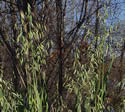 Cultivated Oats plants
Cultivated Oats plants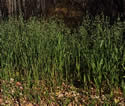 Cultivated Oats planted as a cover crop
Cultivated Oats planted as a cover crop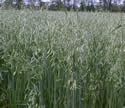 a field of Cultivated Oats
a field of Cultivated Oats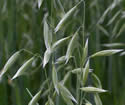 spikelets usually lack awns
spikelets usually lack awns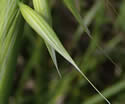 lemmas are sometimes awned
lemmas are sometimes awned
Photos by K. Chayka taken in Aitkin County. Photos by Peter M. Dziuk taken in Aitkin County and in Alabama.
Comments
Have you seen this plant in Minnesota, or have any other comments about it?






